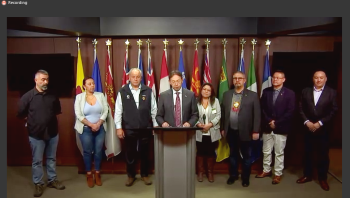Image Caption
Summary
Local Journalism Initiative Reporter
Windspeaker.com
The First Nations Financial Authority (FNFA) is urging the federal government to make a structural change in how it finances infrastructure on reserves.
A new report from the Assembly of First Nations and Indigenous Services Canada (ISC) estimates that the infrastructure gap between First Nations communities and municipalities sits at $349.2 billion.
And that gap will climb if Canada continues with its annual budget method of a cash-spending approach, said FNFA CEO Ernie Daniels in a news conference this afternoon in Ottawa.
FNFA is a federally-legislated, non-profit financial institution that has provided $1.8 billion in loans to fund critical infrastructure and economic development projects in First Nation communities. All of the $1.8 billion in loans is supported by First Nations own-source revenues and provided to communities at an interest rate below what charter banks offer.
Now FNFA wants the federal government to allow them to do the same thing with federal dollars for infrastructure. The proposal would see FNFA issue a debenture (a type of bond or debt instrument that is unsecured by collateral) to finance long-term loans to qualifying First Nations to build critical priority infrastructure on reserve. Canada’s annual transfer would cover the debenture payments.
In order to make this happen, FNFA is calling for a commitment of $200 million in the federal budget for each of the next 20 years. That commitment would allow FNFA to issue a debenture of approximately $3.6 billion, which would allow First Nations to begin to meet the larger priority infrastructure needs in their communities.
That financial commitment from the federal government could increase each year as the program increases in size.
FNFA wants that initial budget commitment to start now. The budget will be delivered on March 28.
This new method, referred to as monetization, is a solution, said Daniels “that prizes partnership over paternalism and the colonial model of providing annual cash to communities that only supports small building projects.”
Monetization is the way municipalities and provinces pay for their infrastructure, he said.
Presently ISC has a $2 billion budget line for on-reserve infrastructure, which only allows First Nations to upkeep existing infrastructure, he said.
Leveraging own-source revenue from First Nations has only a limited impact on the ever-widening infrastructure gap, said FNFA chair Warren Tabobondung, chief of Wasauksing First Nation in Ontario. Much more than own-source revenue is needed to close the infrastructure gap on First Nations.
“Imagine the power of leveraging federal transfers for infrastructure funding,” said Tabobondung.
Any infrastructure improvements, he added, would lay the groundwork for long-term economic growth.
Daniels said FNFA has been pushing the federal government for monetization since 2016. However, Canada has shown a lack of will, he added, to deviate from the “enshrined” current cash-based method.
Last year, the Standing Committee on Indigenous and Northern Affairs recommended that the federal government work with Indigenous institutions to test monetization to transition remote Indigenous communities off dirty diesel fuel to cleaner energy.
“With the monetization concept, the First Nations Financial Authority has the ability to go to the capital market and leverage a stream of revenue that can actually raise this capital. We’ve raised almost $2 billion already based on First Nations own-source revenue,” said Daniels.
FNFA does long-term financing at a fixed interest rate, sometimes for up to 30 years.
“Interest rates are on the high side (now), but at the same time they’re at the low side with what we are able to do,” he said.
In a statement, FNFA said it has earned a rating among international bond rating agencies equal to that of Ontario and Alberta.
“The time for structural change is now. Monetization is not a silver bullet. It will not close the massive infrastructure gap overnight, but we will have a fighting chance to limit the disparity in living standards that have existed for generations and continue today in First Nation communities,” said Daniels.
“We will have an opportunity to right the historical wrongs. We want to seize the opportunity now. We can’t afford to wait another generation for economic reconciliation.”
The FNFA has 151 members First Nations from across the country. It was established by the federal First Nations Fiscal Management Act in 2005.
Never miss a Windspeaker article. Subscribe Today to our new Windspeaker Newsletter!
Local Journalism Initiative Reporters are supported by a financial contribution made by the Government of Canada.

